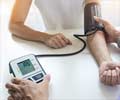New mobile application that measures blood pressure more accurately uses transverse palmer arch artery at the fingertip instead of brachial artery used in arm-cuff devices.

‘Sensor unit attached to the phone uses an optical sensor and a force sensor that provides accurate measurement.’





"We targeted a different artery, the transverse palmer arch artery at the fingertip, to give us better control of the measurement," said Anand Chandrasekhar, MSU electrical and computer engineering doctoral student and the lead author. "We were excited when we validated this location. Being able to use your fingertip makes our approach much easier and more accessible." The approach uses two sensors: an optical sensor on top of a force sensor. The sensor unit and other circuitry are housed in a 1 centimeter-thick case attached to the back of the phone. Users turn on the app and press their fingertip against the sensor unit. With their finger on the unit, they hold their phone at heart level and watch their smartphone screen to ensure they're applying the correct amount of finger pressure.
"A key point was to see if users could properly apply the finger pressure over time, which lasts as long as an arm-cuff measurement," Ramakrishna Mukkamala, MSU electrical and computer engineering professor and senior author said. "We were pleased to see that 90 percent of the people trying it were able to do it easily after just one or two practice tries."
Internationally, this device could be a game-changer. While high blood pressure is treatable with lifestyle changes and medication, only around 20 percent of people with hypertension have their condition under control. This invention gives patients a convenient option, and keeping a log of daily measurements would produce an accurate average, discounting an occasional measurement anomaly, Mukkamala added.
The research team will continue to improve accuracy and hopes to pursue more comprehensive testing based on the standard protocol of the Association for the Advancement of Medical Instrumentation. The scientists are already making inroads to build improved hardware. Future iterations could be as thin as 1 millimeter and be part of a standard protective phone case.
Advertisement
Source-Eurekalert















